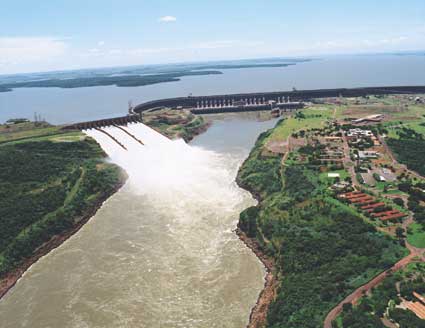Paraguay has possibly the greenest energy in the world. Electricity that is also inexpensive.
Depending upon which source is used you will find a very slight difference in the proportion of energy quote as produced from renewable green sources in Paraguay. Sometimes the figure given is 99% and on other occasions as a full 100%.
This small discrepancy may be down to the age of the data. The last thermal power station in Paraguay closed in December 2021. From then onwards the countries needs have come entirely (apart from a few small solar plants) from hydro-electric power.
This leaves Paraguay in control of it’s own power generation unaffected by movements in the global oil and gas markets.
Electricity in Paraguay is supplied in it’s entirety by three large dams. Two on the River Parana and one across one of it’s tributaries.
By far the largest and most important is the giant Itaipu Dam. This is located on the River Parana just north of the Paraguayan town of Ciudad del Este and Foz in Brazil.
Itaipu Dam was built in the 1970s and was one of the grandest engineering projects of the day. Until the completion of the Three Gorges Dam in China in the early 200os it was the largest hydro electric dam in the world. Behind it formed a lake hundreds of miles long.
The dam was a joint construction project shared between Paraguay and Brazil and half owned by both.
Turbines across the dam wall have a total energy output of 14 Gw. Half belongs to Paraguay and half to Brazil. However in line with terms drawn up in 1973 when the dam was being constructed Paraguay sells 90% of it’s production directly to Brazil. This alone is enough electricity to meet 20% of Brazil’s needs.
Paraguay is one of the world’s largest net exporters of electricity.
Energy requirements have grown greatly over the years in Paraguay but it’s share of the electricity produced at Itaipu has not. There is a possibility that this may be addressed shortly as after 50 years the terms and ratios are due to be renegotiated in 2023.
Despite keeping just 10% of the electricity produced at Itaipu Paraguay is able to meet 86% of the countries needs with it. This includes all domestic electricity consumption.
A second dam named Yacyreta is also sited on the River Parana. This time along Paraguay’s southern border with Argentina. It is a little distance to the west of Encarnacion in Paraguay and Posadas in Argentina.
Although again a large dam it is far smaller than Itaipu and has a generating capacity of 3.2 Gw. The ownership of the dam is shared between Paraguay and Argentina with Paraguay keeping between just 1% and 5% of it’s output.
The third dam is the Acaray Dam. This is much smaller and located within Paraguay across the River Acaray which feeds into the Parana a just to the north of Itaipu. Production here is just 210 Mw. There is however no need to share any of the power output with neighbouring countries.
In terms of the total electricity supply for Paraguay Itaipu generates 86%, Yacyreta 11% and Acaray 3%.
In addition to being green and renewable the electricity in Paraguay is also inexpensive.
As of June 2022 the cost of electricity in Paraguay was $0.065 kWh. This makes Paraguayan energy some of the cheapest in the world.
The global average is $0.16 kWh and far higher than even that in Europe and North America.
Despite having to hand inexpensive electricity Paraguayans do not use it to excess. The annual household consumption is 20% below the South American average.
All is not though perfect with the Paraguayan electric system. There may be seemingly more than could possibly be required but still there are regular blackouts and even power shortages.
Most of this is due to the poor state of the electric infrastructure.
Much of the transmission system is old and in a poor state. An unnecessarily high amount is simply lost as power flows through the distribution system.
Then due to the quality of past workmanship and materials an unacceptable number of power lines are brought down during storms. Either through trees falling across them or the posts which support them simply giving way.
Work though is being done to rectify this. ANDE the national electricity company has an ongoing campaign to repair and modernise the transmission network. Power cuts although they can still be lengthy are far less frequent than in the past.
There is currently construction work happening at both Itaipu and Yacyreta to increase their capacity. Once that is done if treaties can be renegotiated and if the problem of losses from the transmission system can be rectified there is no reason why over the coming years electricity in Paraguay should not become both cheaper still and more reliable.


Anyone interested in hydro power in Paraguay and the Itaipu Dam should read this fascinating and always informative work by an American scholar:
https://www.amazon.com/Hydropolitics-Sovereignty-Engineering-Princeton-Technology-ebook/dp/B07QVFBY67/ref=sr_1_1?keywords=hydropolitics+folch&qid=1680444459&sr=8-1
Anyone interested in Paraguay’s hydroelectric power and the Itaipu Bi-national Dam should read the fascinating and interesting work by the American scholar, Christine Folch:
“HYDROPOLITICS: The Itaipu Dam, Sovereignty, and the Engineering of Modern South America: An in-depth look at the people and institutions connected with the Itaipu Dam, the world’s biggest producer of renewable energy” (Princeton Studies in Culture and Technology, 20 Book 18)